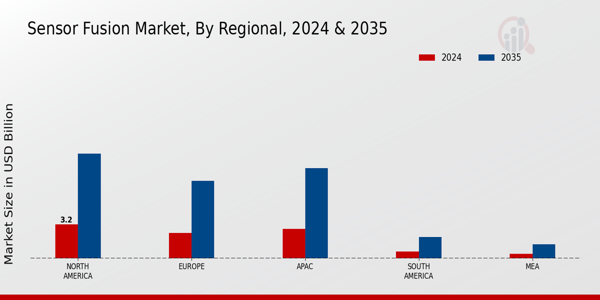Market Trends
Key Emerging Trends in the Sensor Fusion Market
The Sensor Fusion market today is witnessing a plethora of trends resulting in an industry landscape that is quite different from the past. But one of the most obvious trends that can be observed is the integration of Artificial Intelligence (AI) and machine learning algorithms into sensor fusion solutions. By doing this, what is achieved is a capability for processing sensors data which enhances their real time decision making and increases the general efficiency of systems as well. Complex data which requires optimal performance calls for AI powered sensor fusion in usages like robotics, smart cities and autonomous vehicles.
On the other side, The Internet of things (IoT) explosion has also had a significant impact on Sensor Fusion Market. With more connected devices getting online by day, there will be need to have sensor fusion technologies that will be able to combine information from different sensors seamlessly across various platforms. This leads to a comprehensive picture through collecting data from IoT devices thereby promoting adoption of sensor fusion technology in various sectors including healthcare agriculture and industrial automation.
A trend towards smaller, more efficient sensor fusionsolutions has been driven by miniaturization coupled with advancements in sensor technology. The diminutive size and reduced energy consumption alongside widening data capture capabilities for sensing instruments has seen its application expanded into wearable gadgets and portable devices such as smartphones.This can clearly be demonstrated by wearable health monitoring inventions used in medical care that integrate readings taken from accelerometers gyroscope as well as pulse meters among other sensors to give users useful health tips.
Another aspect corroborating this growth reveals higher take-up Of sensor fusion technologies within the automotive sector particularly with respect to advanced driver assistance system(ADAS)and autonomous cars.This means that multiple sensors are used together in order to provide vital features such as collision avoidance,lane departure warning or even adaptive cruise control.Towards achieving better vehicle safety measures,the auto industry projects increasing reliance on these attributes so as make vehicles smarter.
Focus on real-time data processing and edge computing gains ground in Sensor Fusion market. In other words, sensor fusion solutions are now increasing their reliance on the edge of the network where there is decentralized processing to cater for low latency requirements in applications. This is applicable where instant decision-making is a must as seen in smart manufacturing, healthcare monitoring and surveillance systems.
For this reason, cyber security has emerged as one of the major concerns within Sensor Fusion market leading to an emphasized trend on secure measures. There are several applications that deal with sensitive data which are handled by sensor fusion solutions hence it becomes important to ensure its safety and confidentiality. The latest market trends indicate the adoption of encryption, authentication and secure communication protocols as part of sensor fusion systems against possible cyber threats.

















Leave a Comment